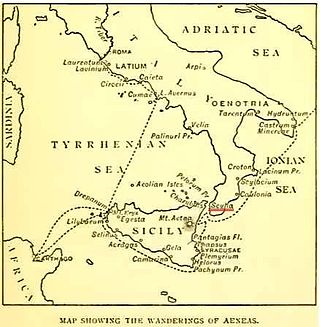- Charybdis
-
For other uses, see Charybdis (disambiguation).
Charybdis or Kharybdis (
 /kəˈrɪbdɨs/; Greek: Χάρυβδις) was a sea monster, later rationalised as a whirlpool and considered a shipping hazard in the Strait of Messina.
/kəˈrɪbdɨs/; Greek: Χάρυβδις) was a sea monster, later rationalised as a whirlpool and considered a shipping hazard in the Strait of Messina.Contents
The mythological background
In Greek mythology, Charybdis or Kharybdis was once a beautiful naiad and the daughter of Poseidon and Gaia. She takes form as a huge bladder of a creature whose face was all mouth and whose arms and legs were flippers and who swallows huge amounts of water three times a day before belching them back out again, creating whirlpools. In some variations of the tale, Charybdis is just a large whirlpool rather than a sea monster. Charybdis was very loyal to her father in his endless feud with Zeus; it was she who rode the hungry tides after Poseidon had stirred up a storm, and led them onto the beaches, gobbling up whole villages, submerging fields, drowning forests, claiming them for the sea. She won so much land for her father's kingdom that Zeus became enraged and changed her into a monster.
The myth has Charybdis lying on one side of a narrow channel of water. On the other side of the strait was Scylla, another sea-monster. The two sides of the strait are within an arrow's range of each other, so close that sailors attempting to avoid Charybdis will pass too close to Scylla and vice versa. The idiom 'between Scylla and Charybdis' has therefore come to mean being between two dangers, choosing either of which will bring harm.
Traditionally, the location of Charybdis has been associated with the Strait of Messina off the coast of Sicily and opposite the rock on the Italian mainland identified with Scylla.[1] The vortex there is caused by the meeting of currents but is seldom dangerous.
References in ancient literature
The Odyssey
Throughout the poem, Odysseus is hindered by the efforts of Poseidon and the sea monsters throughout the ocean. Odysseus faced both Charybdis and Scylla in Homer's Odyssey while rowing through a narrow channel. He ordered his men to avoid Charybdis thus forcing them to pass near Scylla. This resulted in the deaths of six of his men.
Later, stranded on a makeshift raft, Odysseus was swept back through the strait to face Scylla and Charybdis again. This time, Odysseus passed near Charybdis. His raft was sucked into Charybdis' maw, but Odysseus survived by clinging to a fig tree grown on the rock overhanging her lair. On the next outflow of water, his raft was expelled, and Odysseus was able to recover it and paddle away to safety.
Jason and The Argonauts
The Argonauts were able to avoid both dangers because they were guided by Thetis, one of the Nereids.
Aristotle's Meteorologica
Aristotle tells a story of Aesop in conflict with a ferryman and relating to him a myth about Charybdis. She took one gulp of the sea and brought the mountains to view; islands appeared after another. The third will dry the sea altogether.[2]
Ovid's Metamorphoses
In Book VIII of Ovid's Metamorphoses, Scylla betrays her father and country in order to aid Minos, of whom she is enamoured; however Minos is disgusted by Scylla's treachery and sails away without her, provoking a damning diatribe insulting his parentage.
hac quoque si prohibes et nos, ingrate, relinquis, non genetrix Europa tibi est, sed inhospita Syrtis, Armeniae tigres austroque agitata Charybdis.
(If you forbid me from here also and abandon me, you ungrateful one Europa is not mother to you, but the inhospitable Syrtis, an Armenian tigress and Charybdis, whipped up by the south wind.)[3]
The Scylla of this story is to be differentiated from Scylla, the counter-part of Charybdis.
Notes
- ^ Thucydides. History of the Peloponnesian War, 4.24.5.
- ^ Gert-Jan van Dijk, Ainoi, logoi, mythoi: fables in archaic, classical, and Hellenistic Greek literature, Brill NL 1997, pp.351-3; available in Google Books
- ^ See Book 8.81-51 online
References
Categories:- Greek mythology
- Greek legendary creatures
- Naiads
- Whirlpools
- Offspring of Poseidon
- Offspring of Gaia
Wikimedia Foundation. 2010.


